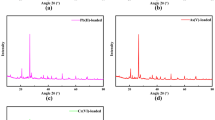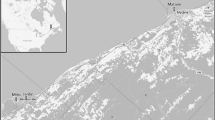Abstract
Physicochemical characteristics relevant to the adsorption of MTBE and Cd on three types of clay minerals were investigated. The characteristics were examined through batch adsorption tests conducted under various experimental conditions such as adsorption time, ratio of solution-to soil, concentration of solutes, concentration of organic matters, pH, and zeta potential. The adsorption efficiency of MTBE or Cd on three types of clays decreased in response to an increase of the ratio of solution-to-soil; nevertheless, the adsorbed amounts inversely increased. MTBE was adsorbed on clays in an increasing order of vermiculite, bentonite, and CTAB-bentonite. However, Cd was adsorbed in a different order of bentonite, vermiculite, and CTAB-bentonite. The adsorption of MTBE was well fitted with the Freundlich model, whereas the Cd was more closely suited to a Langmuir equation. By adding humic acids of 1 and 5%, MTBE was significantly adsorbed on bentonite and vermiculite, respectively, but beyond that, its adsorption was diminished. In comparison, the adsorption on CTAB-bentonite was increased in proportion to the humic acids addition. Likewise, the addition of humic acids acted to increase the adsorption of Cd regardless of the types of adsorbent, where up to 90% of Cd was removed at pH 10. Further increase of pH declined the degree of zeta potential, while increasing Cd concentration also lowered the zeta potential, which consequently contributes in enhancing the adsorption efficiency of Cd on clays.







Similar content being viewed by others
References
Al-Asheh S, Banat F, Abu-Aitah L (2002) Adsorption of phenol using different types of activated bentonites. Sep Purif Tech 33(1):1–10
Ball DF (1964) Loss-on-ignition as an estimate of organic matter and organic carbon in non-calcareous soil. J Soil Sci 15:84–92
Boyd SA, Mortland MM, Chiou CT (1988) Sorption characteristics of organic compounds on hexadecyltrimethyl ammonium smectite. Soil Sci Soc Am J 52:652–657
Brownawell BJ, Chen H, Collier JM, Westall JC (1990) Adsorption of organic cations to natural materials. Environ Sci Technol 24(8):1234–1241
Di Leo P (2000) A nuclear magnetic resonance (NMR) and Fourier-transform infrared (FTIR) study of glycine speciation on a Cd-rich montmorillonite. Clays Clay Miner 48(5):495–502
Di Leo P, O’Brien P (1999) Nuclear magnetic resonance (NMR) study of Cd2+ sorption on montmorillonite. Clays Clay Miner 47(6):761–768
FitzPatrick EA (1986) Soils: their formation. Classification and distribution. Longman Science & Technical, London, p 353
Inskeep WP, Baham J (1983) Adsorption of Cd (II) and Cu (II) by Na-montmorillonite at low surface coverage. Soil Sci Soc Am J 47:660–665
Jonson R, Pankow J, Zorgorski J (2000) MTBE-To what extent will past releases contaminate community water supply wells? Environ Sci Technol 34:210A
Jung MC (1995) Heavy metal contamination of soils, plants, waters and sediments in the vicinity of metalliferous mines in Korea. Ph. D. Thesis, University of London, 455
Jung HJ, Lee MH (2002) A comparison of TCE adsorption on types of soil. Kor Soc Soil Groundwater Environ 19:362–365
Kim HG, Lee SB (1998) Effects of organic matter on cadmium adsorption in soil. J KSEE 20(1):1–8
Korea Environment Institute (KEI) (2002) A potential risk and its proper handling of fuel additive MTBE. J Environ Policy 17:313
Mohamed AMO, Antia HE (1998) Geoenvironmental engineering, developments in geotechnical engineering 82. Elsevier, Amsterdam, p 520
Weber WJ (1992) Physicochemical processes for water quality control. Wiley, New York, pp 204–273
Xu S, Boyd SA (1994) Cation exchange chemistry of hexadecyltrimethyl ammoniumin a subsoil containing vermiculite. Soil Sci Soc Am J 58:1382–1391
Xu S, Sheng G, Boyd SA (1997) Use of organo-clays in pollution abatement. Adv Agron 59:25–62
Yoo JY, Choi JY, Park JW (2001) Adsorption of cadmium and lead on organobentonite. J KoSSGE 6(3):21–29
Acknowledgment
This research was financially supported by an Inha University Research Grant.
Author information
Authors and Affiliations
Corresponding author
Rights and permissions
About this article
Cite this article
Sim, JH., Seo, HJ. & Kim, CG. Physicochemical characteristics for adsorption of MTBE and cadmium on clay minerals. Environ Earth Sci 59, 537–545 (2009). https://doi.org/10.1007/s12665-009-0051-3
Received:
Accepted:
Published:
Issue Date:
DOI: https://doi.org/10.1007/s12665-009-0051-3




